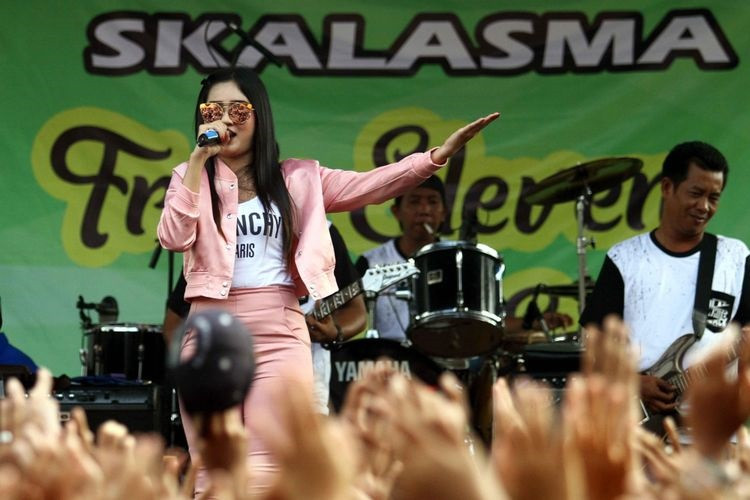Popular Reads
Top Results
Can't find what you're looking for?
View all search resultsPopular Reads
Top Results
Can't find what you're looking for?
View all search resultsDangdut, UNESCO and the hidden potential of intangible cultural heritage
Weintraub thinks that dangdut not only reflects national politics and social settings, but in terms of economic, political and ideological practices, dangdut has also played a role in shaping the perspectives of class, gender and ethnicity in modern Indonesia.
Change text size
Gift Premium Articles
to Anyone
I
magine if iconic world music was internationally recognized as intangible cultural heritage. The United States has Hollywood, South Korea has K-Pop, and Indonesia has dangdut.
The discussion on proposing dangdut as an internationally recognized example of intangible cultural heritage has been around for a while. During Agung Laksono’s tenure as the coordinating people’s welfare minister from 2009 to 2014, he was the first person to support the king of dangdut, Rhoma Irama, in promoting dangdut for recognition by UNESCO as a part of Indonesia’s intangible cultural heritage. The support was conveyed on March 3, 2012, during the opening ceremony of the national congress of the Dangdut-Malay Music Performers Association (PAMMI) in Surabaya.
After nine years, on March 30 of this year, support for dangdut revived. The Tourism and Creative Economy Ministry, alongside PAMMI, renewed discussions on the possibility of getting UNESCO to recognize dangdut. Tourism and Creative Economy Minister Sandiaga Uno responded positively by preparing a team to submit a proposal to UNESCO. The Directorate General of Multilateral Cooperation at the Foreign Ministry also stated its support.
Sandiaga said dangdut music had great potential to contribute to the tourism and creative economy sector, including by creating jobs and developing large-scale industry.
There are several requirements to apply for UNESCO recognition of cultural heritage. First, it has to be part of the cultural identity of one or more cultural community. Second, the proposal must be filed by the community and at least one master of the form who is still active. Third, it must have been inherited generationally, or at least be an art or cultural form that is more than fifty years old.
Andrew Weintraub, a music professor at the University of Pittsburgh, in his book Dangdut Stories: A Social and Musical History of Indonesia's Most Popular Music (2010), quoted William Frederick from the University of Ohio as stating that dangdut was a reflective and useful prism to view Indonesian society.
Furthermore, Weintraub thinks that dangdut not only reflects national politics and social settings, but in terms of economic, political and ideological practices, dangdut has also played a role in shaping the perspectives of class, gender and ethnicity in modern Indonesia.
In an interview with music history archival program Shindu’s Scoop, Prof. Tjut Nyak Deviana, a musical pedagogue, said dangdut and keroncong music are the two Indonesian genres that have the most potential to enter the global music market.
Indonesia has submitted a number of forms of cultural heritage to UNESCO, but the effort is far from enough given the country’s richness in intangible cultures. According to a 2009-2017 report by the Directorate of Cultural Inheritance and Diplomacy under the Directorate General of Culture at the Education, Culture, Research and Technology Ministry, at least 7,241 cultural forms have been registered as part of the country’s intangible culture. The number of cultural forms has increased from 77 in 2013, to 96 in 2014, to 121 in 2015.
In the last 13 years, UNESCO has recognized nine forms of intangible Indonesian cultural heritage, namely keris (kris dagger making), wayang (shadow puppetry), angklung (bamboo music instrument), Papuan noken (woven bags), three Balinese traditional dances, the art of pinisi boat-making in Southern Sulawesi, the pencak silat martial art and pantun (a rhymed poetic form). The number does not even make up 1 percent of the total potential intangible cultural heritage forms registered with the Education, Culture, Research and Technology Ministry. This means the inventory is still open for updates and that many other intangible heritage forms need to be fought for in order to increase the level of international recognition.
The Directorate of Cultural Inheritance and Diplomacy at the Education, Culture, Research and Technology Ministry has been taking the inventory of, designating and nominating intangible cultural heritage forms. In its 2017 report Designation of Indonesian Intangible Cultural Heritage, the ministry called for the participation of more parties – such as regional governments, the public and the cultural law community – in the designation process.
The inventory work has so far involved 11 Centers for the Preservation of Cultural Values across the country. The process before the government submits a request to UNESCO takes a long time, as assessments of the eligibility of a cultural heritage form for world recognition consist of many stages.
The effectiveness and speed of the inventory system needs a review. The utilization of big data in the program, as advised by Sandiaga, has yet to show any impact. Considering the fact that the archipelagic country has more than 17,500 islands, the current number of intangible cultural heritage forms recorded does not add up. Let’s say each island has at least two intangible cultural heritage forms. Then, there should be at least 35,000 intangible cultural heritage forms in the country.
It remains far-fetched to expect UNESCO to declare dangdut an Indonesian cultural heritage anytime soon, but the government’s submission of its official bid will trigger a wave of applications coming from Indonesia. In this matter, the Education, Culture, Research and Technology Ministry, the Foreign Ministry and Tourism and Creative Economy Ministry play a pivotal role.
Love for Indonesia’s cultural heritage is a continuous movement starting from this point onward. As one line of a popular dangdut song goes, “I love dangdut because dangdut is the music of my country!”
***
The writer is a part time lecturer, Event Department, University of Prasetiya Mulya.










